U.S. Department of Transportation
Federal Highway Administration
1200 New Jersey Avenue, SE
Washington, DC 20590
202-366-4000
Federal Highway Administration Research and Technology
Coordinating, Developing, and Delivering Highway Transportation Innovations
|
Research & Technology Transporter This newsletter is an archived publication and may contain dated technical, contact, and link information. |
|
| Publication Number: N/A Date: July 1997 |
Publication Date: July 1997
|
The Research & Technology Transporter was a Federal Highway Administration (FHWA) research and technology publication issued under FHWA's Research and Technology Program. The 8-page newsletter transmitted research and technology-based developments from FHWA program offices to engineers in the field and professionals in the industry. Publication of the Research & Technology Transporter ended with the September 2006 issue.
| Rodney E. Slater Secretary, U.S. Department of Transportation |
| Jane F. Garvey Deputy Administrator, Federal Highway Administration |
| Anthony R. Kane Executive Director Federal Highway Administration |
| RTCG CHAIRPERSONS |
|---|
| Michael Trentacoste - Safety Stan Gordon - Structures Paul L. Brennan - Motor Carriers Don Steinke - Highway Operations Paul Teng - Pavements Jeff Lindley - ITS King Gee - International Barna Juhasz - Planning, Environment, and Right-of-Way Gary Maring - Policy & Information Management |
| Anne Barsanti, Managing Editor Jon Schans, Editor Zac Ellis, Editor |
It has not gone unnoticed that the American Society for Testing and Materials' (ASTM) Subcommittee E12.08, High Visibility Materials, has been working extremely hard to make pedestrian clothing more visible to motorists. On May 17 at the Turner-Fairbank Highway Research Center (TFHRC), the subcommittee held a workshop to develop a research methodology for establishing material requirements for various levels of conspicuity.
The subcommittee is currently developing standards for making pedestrian safety clothing more visible during the day and at night. It has already published the standard for nighttime conditions and expects to have the daytime standard published by next spring. The nighttime standard includes specifications for color, brightness, and coverage of fluorescent materials.
The E12.08 standards are unique from many other ASTM standards since they involve the factor of human perception. The assignment of the subcommittee is further complicated by the fact that the two standards attempt to address a variety of pedestrians, including casual walkers and highway workers.
ASTM is currently following the model set by European high visibility clothing standards in establishing three classes of usage. The first class is recommended for the casual walker, jogger, or biker. The second class is intended for professional use (e.g. parking attendants and crossing guards). The third class is recommended for industrial applications, such as highway construction and airport workers. The recommended size of the material increases as it goes from class 1 to 3.
The workshop's efforts were concentrated on determining a method to quantify the conspicuity or attention-getting value of various materials. Participants used a method of limited exposure to the stimulus, which would appear at various distances and offsets.
The subcommittee observed several different fluorescent colors and configurations of materials during the daytime. After nightfall, the group observed retroreflective materials with varying levels of retroreflectivity, colors, and patterns.
The working group is planning to report their observations and findings to the E12.08 subcommittee on June 20 at the E12, Visibility Committee, meeting in St. Louis, Missouri.
Dan Turner, jonathan.turner@fhwa.dot.gov.
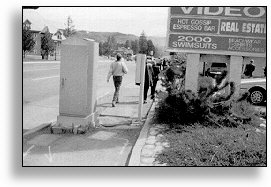 |
| The Pedestrian Safety Road Show encourages local groups to find solutions to pedestrian issues such as this obstructed sidewalk. |
From April 30 to May 2, the first train-the-trainer session for the Community-Based safety pedestrian program known as the Pedestrian Safety Road Show was successfully held in South Lake Tahoe, California. Attending were representatives from the National Highway Traffic Safety Administration (NHTSA), Governor's Office of Highway Safety, Metropolitan Planning Organizations (MPO's), State DOT's, Local Technical Assistance Program (LTAP) Centers, local public sector, and FHWA division offices in Region 9.
The program encourages participants to form a local group of pedestrian advocates, whether in a public agency or an organized external group, to focus on identifying and solving potential problems that affect pedestrian safety and walkability. The Road Show also explains the tools that are available to local communities.
A unique aspect of the program is that it allows field offices to take a leadership role in delivering the technology to local communities. Partnerships to help deliver the technology are also being sought with private organizations. For example, the Environmental Protection Agency through its Transportation Partners Program has just awarded a major grant to the Bicycle Federation of America (BFA). BFA anticipates using a portion of these new funds to facilitate the Pedestrian Safety Road Show.
There is high interest in the program with over 200 requests nationwide. The Road Show addresses a major, intermediate need of the local community. Our challenge is to create an environment of change in which all communities buy into the concept of pedestrian safety and walkability. You are invited to take advantage of this opportunity to have people trained to facilitate the Road Show in your area. Training sessions for facilitators are being set up in region 10 (August 5-7, Washington), Region 4 (October, Florida), and Regions 5 and 7 (date and location to be determined). For more information, check our Web page at www.ota.fhwa.dot.gov/walk/, or call L. Boodlal.
- Leverson Boodlal, (202) 366-8044.
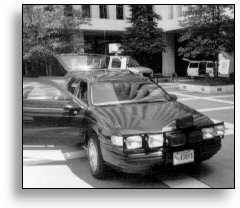 |
| DASCAR with UV headlights displayed in courtyard of DOT headquarters. |
The configuration of ultraviolet (UV) headlamps mounted on the front of a vehicle equipped with a Data Acquisition System for Crash Avoidance Research (DASCAR) stirred quite a bit of curiosity at the DOT Open House held on May 19. The vehicle, a 1994 Taurus Station Wagon, was instrumented by NHTSA with the ability to record up to 33 parameters, including lateral placement, geographic placement, steering movements, throttle and acceleration. Even the rear defrost button is fed as an input, along with the other parameters, into the computer located in the rear of the vehicle. Four cameras are hidden in the vehicle to capture two views of the driver and a front and rear view out of the vehicle.
FHWA's Traffic and Driver Information Systems Division is using the DASCAR technology to evaluate the use of the UV headlamps. The headlamps are mounted on the front of the vehicle along with both U.S. and European headlamps. Photographs were displayed on poster boards to demonstrate the effectiveness of the UV headlamps.
Open house attendees were generally intrigued by the increased visibility of the roadway markings and pedestrians with the use of the UV headlamps. Some of the most asked questions were:
Q: How soon can they be purchased?
A: The UV headlamps are prototype technology. The current research efforts will continue for about 5 more years, so it will be quite a while before the headlamps will appear in the marketplace.
Q: What do they look like to oncoming drivers?
A: Since the UV light is invisible to the human eye, there is very little glare, just a purple haze when motorists look directly into the lights.
Q: How much more will cars cost with these lights?
A: The prototype technology is very expensive; however, it is expected that the headlamp manufacturers could refine the technology to be relatively inexpensive.
Q: Can I put a UV light bulb in my current high-beam housing?
A: No. The gas discharge bulb requires more power and the use of several unique filters.
Q: Were pedestrians who participated in the demonstrations wearing special clothing?
A: No. The clothes they were wearing were purchased at a local department store and washed one time. Standard laundry detergents contain fluorescent materials which react with the UV to create visible light, thus making the pedestrians easy to see.
Attendees to the open house were generally excited about the prospect of having the UV headlamps on their vehicles and were inquisitive about their availability. Older drivers commented that they were hopeful this new technology would eliminate some of the frustration they have when driving at night.
Dan Turner. jonathan.turner@fhwa.dot.gov or Samuel Tigno, sam.tignor@fhwa.dot.gov.
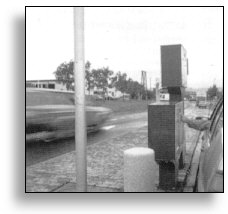 |
| The Trondheim Toll Ring offers two ways to pay at the unattended toll plaza: By using a Q-FREE tag as the car on the right has done, or by placing coins in the machine as the car on the left is doing. |
Since its inception in 1991 under the Intermodal Surface Transportation Efficiency Act (ISTEA), the FHWA Congestion Pricing Pilot Program has encouraged States and localities to implement and evaluate the concept of variable road pricing. This task has not been easy since variable road pricing had not been tested in the United States until 1995, when State Route 91, in Orange County, California, was opened.
As a result, the Congestion Pricing Team has used international experiences to show that congestion pricing can be an effective traffic management tool. One real-world example on which the Congestion Pricing Team has relied heavily is the automatic Toll Ring of Trondheim, Norway.
Trondheim, a city with over 140,000 inhabitants and a history of over 1,000 years, has long struggled with auto congestion and the accompanying noise, accidents, and air pollution. To raise revenue for system improvements and alleviate peak-period congestion, the City Council in the 1980's proposed an urban road tolling system.
The Toll Ring, openend in October 1991, is comprised of toll booths located on all roads serving the city center, thereby creating a cordon or ring around the city. The system, marketed as the Q-FREE system, uses electronic readers to identify vehicles and automatically deduct charges from drivers' pre-paid accounts.
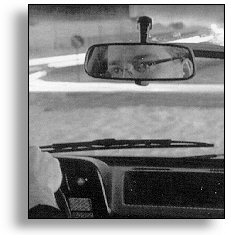 |
| The Q-FREE tag behind the rear mirror gives a discount and allows you to pass at ordinary driving speed. |
Tolls are charged to all in-bound traffic (excluding motorcycles and public transit) during the weekday hours of 6 a.m. and 5 p.m., with the highest toll between 6 and 10 a.m. when demand is highest.
Results so far are very promising. According to Mr. Tore Hoven, senior traffic engineer for the Norwegian Public Roads Administration, the city has experienced a 10-percent reduction of in-bound autos during toll hours and a 7-percent increase in weekday bus travel. As a result of the revenues generated, Trondheim residents are enjoying higher quality roads, pedestrian and bicycle facilities, and public transport.
Public support for the Toll Ring has been high because of the transportation system improvements. Because of Trondheim's successful experiment, FHWA's Congestion Pricing Team has had Mr. Tore Hoven, who is currently spending time in the United States during a 1-year sabbatical from his normal duties, participate in several of its regional workshops.
- Tom Keane, (202) 366-9294
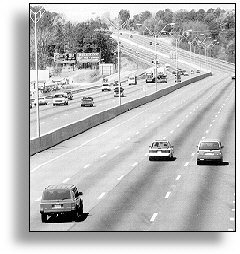 |
| The new HPMS data collection software will be used by the States to provide FHWA with information on their roadway systems' length, use, physical condition, operating characteristics, and safety. |
The FHWA Office of Highway Information Management (OHIM) has just completed hands-on training workshops for new Windows®-based Highway Performance Monitoring System (HPMS) data collection software.
During March and April, OHIM conducted the workshops in Atlanta, Baltimore, Denver, and Kansas City. The workshops, which were attended by both State and FHWA field personnel, provided an opportunity for the attendees to work with the new software, ask specific questions, and provide feedback to FHWA Headquarters. All but four States attended the workshops.
The new HPMS data collection software will be used by the States to provide FHWA with information on their roadway systems' length, use, physical condition, operating characteristics, and safety. It replaces the existing mainframe and DOS-based software the States currently use to report the information to FHWA. It enables the States to update data in the field using laptop computers which could not be done with the previous software. States will be able to verify data and run reports to help them better respond to data requests.
During development of the software, several States assisted FHWA by pilot testing the software and providing feedback. Four of the pilot States (Connecticut, North Dakota, Oregon, and Washington) agreed to attend the workshops. The pilot States talked about their experience with the software, provided assistance to other States based on their experience, and gave suggestions on how to use the software from a State's perspective. Each workshop was attended by one of the four pilot States.
Overall, the software was well received by the States. Most States expect to use the new Windows®-based system for the 1997 data reporting year in June 1998. Feedback received from the workshops is being used to enhance the system to better meet the needs of the States.
- Beverly Harrison, (202) 366-4048, and Janet Tierney, (202) 366-5021.
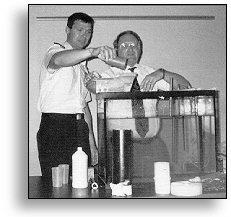 |
|
| LT Ken Marien (USCG's Civil Engineering Unit) helps instructor Michael Garlich with a classroom demo during the DP 98 workshop held in Miami. | |
On April 29 and 30, the Office of Technology Applications' (OTA) Demonstration Project 98 (DP 98), Underwater Evaluation and Repair of Bridge Components, began reaching new customers. It was presented to the U.S. Coast Guard's Civil Engineering Unit in Miami, Florida, and to guests of the Coast Guard, which included the Dade County Port Authority and the CSX Railroad.
Lieutenant Keith Ingalsby, training officer for the Coast Guard unit, praised the presentation as a good example of interagency cooperation since it gave his unit up-to-date technical information for use in current projects.
It was pointed out during the presentation that evaluation techniques and repair procedures used by bridge engineers are applicable to many types of underwater structures. A pile doesn't care whether it is carrying a bridge or a dock; it sees the same type of load and deterioration.
DP 98 uses a hands-on approach for providing engineers an opportunity to experience some of the latest technologies and repair products for underwater use. It is especially relevant to the States since they have completed several underwater bridge inspections and are now very involved in underwater repairs.
DP 98 is intended for Federal, State, and local engineers responsible for designing, inspecting, and maintaining bridges and related facilities. It has been presented all over the country from Alaska to Texas and Maine to Florida. To schedule a presentation, contact OTA.
- Tom Krylowski, (202) 366-6771.
Then check out the Hydraulic Design Series Number 2 (HDS-2), Highway Hydrology. OTA and the Bridge Division have distributed the publication to State highway agencies and FHWA offices. HDS-2 supercedes FHWA's 1984 publication Hydraulic Engineering Circular 19, Hydrology.
HDS-2 discusses the physical processes of the hydrologic cycle that are important to highway engineers and the methods that are used to design highway drainage structures. Hydrologic methods of primary interest are frequency analysis for analyzing gauge station data, empirical methods for estimating peak discharges (e.g. use of regression equations, rational method, or the SCS Graphical method), and hydrograph analysis and synthesis. New topics include arid lands hydrology, stormwater management, and the role of geographic information systems in hydrologic modeling. All equations and computations in the manual are metric.
A new National Highway Institute (NHI) course, Practical Highway Hydrology (Course No. 13067), is being developed using HDS-2 as its primary reference. Additional copies of HDS-2 can be obtained from FHWA's R&T report center at (301) 577-0906 while supplies last. the publication number is FHWA-SA-96-067. The manual is also available through the National Technical Information Service (NTIS #PB97-134290).
- Abbi Ginsberg, (202) 366-8080.
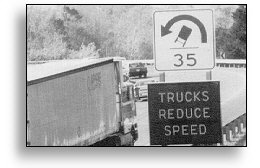 |
|
| The brochure includes many new technologies already in use in the Washington, DC metropolitan area, such as a quick response system for clearing accidents from the road, truck rollover sensors (photo), and the Dulles Toll Road pre-paid toll facilities. |
|
The Washington Metropolitan Region Technology Brochure is now available on the World Wide Web at www.hend.com/techmap. The publication and Web page show new transportation technologies that are being implemented in the Washington, DC metropolitan area.
The publication enhances the service-oriented images of transportation agencies by showing how new technologies are being used to make travel quicker, safer, and easier. The principal target audience for the publication is the general public. The text and pictures emphasize user benefits in contrast to most publications about transportation technology that emphasize the technology. Response to the publication, which has been distributed at conferences, to groups that visit partnering agencies, and to public officials, has been very positive.
The technology brochure and Web page project is a joint effort of the Virginia DOT, Maryland DOT, District of Columbia Department of Public Works, Washington Metropolitan Area Transit Authority, Metropolitan Washington Council of Governments, AAA Potomac, and FHWA.
Technology coordinators from the participating agencies helped develop the publication's content, while marketing and public relations personnel worked on the design and distribution strategies, which ultimately will be expanded to include AAA offices and Interstate areas. After the initial printing and distribution in January 1997, additional partners are being sought to broaden the content before the brochure is revised and reprinted. The revised publication will include more information about the Washington metropolitan area's Traveler Information System, which will be unveiled this month.
The project was designed to serve as a model for similar efforts elsewhere. FHWA's Region 7, in cooperation with the Iowa, Kansas, and Missouri DOT's, is working on a similar publication showcasing products from the Priority Technologies Program. Other States and regions also are considering doing their own tech maps.
- Margie Sheriff, (202) 366-1747.
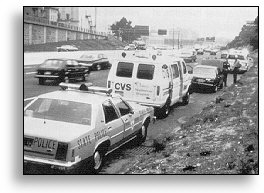 |
|
| New WAIMSS software along with NHI's Incident Management course provide freeway management personnel with strategies to quickly and effectively manage traffic incidents. | |
Incident management is the management of a non-recurrent event (e.g. crashes, work zone projects, and vehicle breakdowns) which causes a reduction in roadway capacity or an abnormal increase in demand. FHWA has been involved in two recent efforts to manage incidents: the Wide Area Incident Management Support System (WAIMSS) and a new NHI course on Incident Management (Course # 13348).
WAIMMS, which is being used in the Suffolk and Northern Virginia areas, was developed by the Virginia tech Center for Transportation Research through FHWA's OTA and Office of Research and Development. Its goal is to assist incident management personnel with appropriate strategies to manage traffic incidents and execute the steps required for effective and timely implementation. For example, the software includes modules that predict incident duration and suggest detour routes in real time.
The Incident Management course is available in a 1- or 2-day format. It was developed in response to the success of DP 86, Relieving Traffic Congestion Through Incident Management, which is a 2-day workshop sponsored by OTA. Both DP 86 and the Incident Management course are taught by the Washington State Transportation Center.
The WAIMSS and DP 86 projects have been completed, and summary reports are available upon request. Federal, State, and local partners who would like to purchase a session of the NHI course should contact the local FHWA division office nearest them.
Morris Oliver, (202) 366-2251.